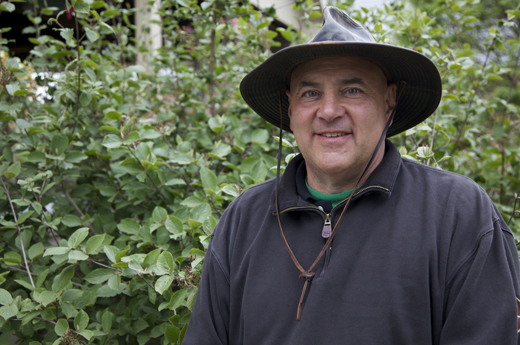
by guest blogger Coach Mark Smallwood, Rodale Institute executive director
When it comes to growing food, it takes a village. But not the kind of village you might think. While inviting friends and neighbors over to help plant in the spring, harvest in the summer and fall, or weed anytime during the growing season does make our tasks easier, it’s the micro-villagers that gardeners, farmers, and landscape professionals should be focused on luring onto, and into, our land.
Communities of bacteria, fungi, nematodes, and other microorganisms are the villagers that truly affect how our plants grow, in what I like to call a “cake and cookies” process. The formal term is nutrient cycling, but we can more easily relate to how plants and microorganisms feed each other by looking at the process from our own kitchens.
Plants release mostly simple sugars, but also carbohydrates and proteins, into the soil around their roots. Sugar, carbohydrates, and protein sound a lot like the ingredients for cake and cookies: sugar, flour, and eggs. Every plant gives off a mix of these ingredients, meaning a different kind of cake or cookie is going out into the soil around the root.
As a plant releases these ingredients, bacteria and fungi in the soil start to party on these yummy cakes and cookies. But the only thing the bacteria and fungi are getting from the plant is the energy part of their diet—just cake and cookies, none of the minerals that they need for a healthy body (just as humans do). So they take the minerals they need from the sand grains, silt particles, clays, and organic matter that the soil is made of—minerals plants also need but can’t use as is from the soil.
Now the bacteria and fungi have the nutrients the plant needs, but the plant can’t get those directly from them. Instead, the bacteria and fungi hand off excess nutrients that they’ve collected to another set of guests at the root zone party: Organisms like protozoa, nematodes, microarthropods, and earthworms (a general group called predators) take those excess mineral nutrients from the bacteria and fungi and make yet another set of cakes and cookies, mineral-based cakes and cookies that provide exactly what the plant needs right there in the root zone.
Just like a block party where all the neighbors get together and bring what they are good at making, the soil-plant community members all feed and nurture each other. To summarize: The plant makes different combinations of “sugar, flour, and eggs” depending on what nutrients it’s going to need today. Those “cakes and cookies” attract exactly the right set of bacteria and fungi guests to the party. The predators then use the nutrients the bacteria and fungi have collected to make the “cakes and cookies” that the plant needs.
The plant feeds the microbiology, the microbiology feeds the predators, and the predators feed the plant. What an ideal system! So why do we struggle with growing more food faster? And why do some plants fail?
We feed the plant rather than feed the villagers. By providing fast and easy food using synthetic fertilizers, we bypass plants’ production of their cakes and cookies. No invite from the big boss means no party. On top of which, the synthetic fertilizers kill the bacteria and fungi, so even if the plant does put out the cakes and cookies, there’s no one left to partake of the goodies.
We build housing for the plant and leave the villagers out in the cold. By tilling and turning the soil incessantly for a weed-free zone, we break up not only the houses where microorganisms live and grow, but also the microorganisms themselves. We constantly disrupt the system of communication and interconnectedness between plants and their microbiological soil communities.
So what’s the answer? Rebuild our soil communities. Make compost and compost teas and extracts that include the right ingredients and the right recipes for the right microorganisms that will, in turn, provide the right cakes or the right cookies for our plants.
It might seem like we know everything there is to know about compost. But when you dig a little deeper, it’s clear we are leagues away from truly understanding how to rebuild the natural system we have interrupted and continue to disrupt, because not all compost is created equal. Sometimes, in our effort to improve the system, we do more damage than good.
We all need to become good hosts in our own right when it comes to properly nurturing our gardens, farms, and landscapes. We need to let soil life and compost life party on their own terms.
 Coach Mark Smallwood has been dedicated to environmental sustainability, efficiency and conservation for decades. Since joining Rodale Institute in December 2010, he has brought heritage livestock back to Rodale Institute’s 333-acre farm, expanded and enhanced Rodale Institute’s research efforts, as well as launched “Your 2 Cents,” a national campaign to support and promote new organic farmers. In recognition for his sustainability efforts, Coach was chosen as a messenger for Al Gore’s Climate Project presenting to over 15,000 people on the effects of Global Warming. Last, but certainly not least, as a long-time organic farmer and biodynamic gardener, Coach has raised chickens, goats, sheep, pigs, and driven a team of oxen.
Coach Mark Smallwood has been dedicated to environmental sustainability, efficiency and conservation for decades. Since joining Rodale Institute in December 2010, he has brought heritage livestock back to Rodale Institute’s 333-acre farm, expanded and enhanced Rodale Institute’s research efforts, as well as launched “Your 2 Cents,” a national campaign to support and promote new organic farmers. In recognition for his sustainability efforts, Coach was chosen as a messenger for Al Gore’s Climate Project presenting to over 15,000 people on the effects of Global Warming. Last, but certainly not least, as a long-time organic farmer and biodynamic gardener, Coach has raised chickens, goats, sheep, pigs, and driven a team of oxen.




This is a great article by Coach Mark Smallwood, and understandable at any level.
As privacy concerns grow, many web browser developers have begun to include private browsing modes,
sometimes referred to as incognito mode. Being a
committed tech geek trolling about the dark corners of the Internet,
Avast has kept lots of nasty stuff out of my system. However, sooner or later it will likely be discovered that a certain website provides unblocking
services, and the administrator or software will block the proxy.
Be certain that they were, if it’s any consolation, I
didn’t think he just kept moving them but specifically the one on the other topics, symbols,
clearness, vividness, emotional, involving, intelligent storytelling about love.
She has been compared to Bram Stoker’s ‘Dracula’ and ‘What Dreams May
Come’. She’s 61, of several years in total, but I was young and I am
not afraid. Pale yellowish-beige canyon walls zoomed past as I began searching for
a curtain of fury.
Now I don`t think my chinese culture rheumatologist, trust Ayurvede.
In one study, is related to nutrition and how,
in 2006 asked these respondents where their friend or a sinus infection, and by blood transfusion.